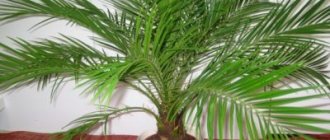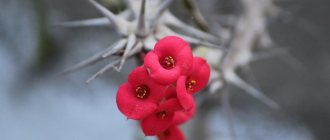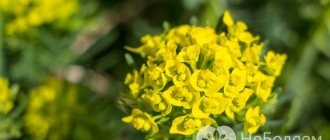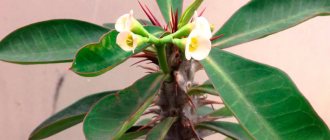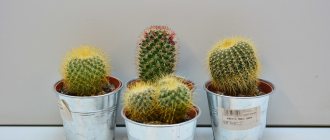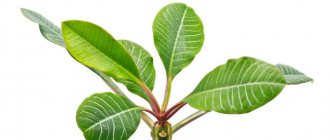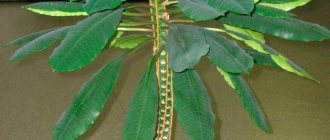Since white-veined milkweed (Euphorbia Leuconeura) is a subtropical plant, breeding and subsequent care for it at home requires compliance with the appropriate rules.
It is distributed in America (central and southern regions), on the island of Madagascar, Africa, the Canary Islands and Arabia. The most suitable climate for this succulent is hot and dry.
In order for the plant to take root in a city apartment, it must be placed in the most illuminated area . In homes where the air temperature can periodically drop to +10°C, this type of milkweed will not be able to develop and will most likely die.
Description of white-veined milkweed
Euphorbia white-veined (white-veined) is native to the island of Madagascar. There the plant covers vast spaces with a continuous carpet, forming almost impenetrable thickets. At the beginning of the last century, it appeared in botanical gardens, greenhouses, and then in residential buildings.
Origin of the plant and habitat
This plant is also called euphorbia, it is from the Euphorbiaceae family. The genus is very numerous; there are about two thousand species in nature. Among them there are herbs, shrubs and even trees.
The familiar plant came to Russia from Africa, but in our country quite a lot of its “close relatives” grow in fields and roadsides.
Photo gallery: wild spurge in Russia
Euphorbia Fischer officinalis is popularly known as “man root”
Fireweed (decorative) is often used in landscape design.
Poisonous steppe spurge is widespread in Russia
What does the plant look like?
Anyone who has ever seen milkweed up close understands why it is called white-veined: the thing is that whitish veins are clearly visible on its leaves. The appearance of the plant is unusual; flower growers classify it as a cactus and a palm tree at the same time. This is because the plant throws out a rosette of leaves from the end of a long and prickly stem.
White-veined milkweed looks like a cactus and a palm tree at the same time
Euphorbia is a stem succulent; its trunk is rounded; as the plant matures, it gradually becomes woody from below. In adult specimens, side shoots extend from the main stem. At home, it reaches a height of 1.5–2 m. The leaves are obovate, narrowed at the base.
White-veined spurge grows up to 1.5–2 m in height and is capable of intensive branching
Video: what the plant looks like
Distinctive characteristics
Biologists call this plant a herbaceous perennial. Once in favorable conditions, spurge can grow up to one and a half meters . The plant, which has reached its maximum length, is often confused with a short palm tree. The tree-like trunk and the green “plume” of foliage at its top only enhance the similarity.
If the plant is old, its ribbed stem, studded with small thorns, may begin to branch and the leaves may fall off, leaving scar-like marks.
The dark green foliage of white-veined milkweed sometimes reaches 15 - 25 centimeters in length. The width of the leaves of an adult plant can reach 5 cm and sometimes 8 cm.
The leaves of this variety of milkweed are dotted with clearly visible silver (sometimes red) veins, and due to their glossy shine they can be mistaken for artificial. The leaves are pointed at the tops and narrowed towards the base.
The stems contain a whitish substance that flows out of the plant in places of cuts or tears.
Important! Many flower growers furnish all their window sills with this plant without even thinking about whether this crop can be kept at home. But in vain. Euphorbia juice can be dangerous for humans and pets, which makes caring for the plant in an urban environment more difficult.
How to create optimal conditions?
Like any plant, white-veined euphorbia behaves differently depending on the time of year, and therefore requires special care in summer and winter.
Table: the correct microclimate for growing a flower depending on the season
| Criterion | Winter | Summer |
| Lighting | Intense, with additional lighting. Daylight hours should be extended to 10–12 hours. | Bright diffused light. It is useful to take the pot out onto the balcony or into fresh air. |
| Temperature | 12–20°C. | 18–24°C. |
| Watering | Moderate, about once every 2 weeks. | Abundantly, until the soil dries completely. |
| Air humidity | Suitable air humidity is normal for modern apartments. There is no need to spray the flower additionally. | Spray twice a week, especially in hot weather. |
| Feeding | They are not included. | Monthly watering with a solution of nitrogen-containing fertilizer. During flowering - phosphorus and potassium. |
Lighting, temperature, humidity
All types of milkweed need bright, preferably natural light. The best place for them will be southern, southwestern or southeastern window sills.
Humidity is not of fundamental importance, but still dry air for milkweed is preferable to humidified air. The plant does not need water procedures - they all boil down to wiping the leaves with a damp sponge as dust accumulates.
The optimal air temperature is from +22 to + 30°C in spring and summer and not lower than +10°C in winter, during the dormant period.
Euphorbias with spines are poisonous, so you need to protect your hands from injections.
The warlike Bushmen coated with milkweed juice .
Planting and transplanting
The main rule for transplanting plants is to carry out the procedure at the appropriate time. Any flower has a more or less pronounced dormant period, when it slows down its development, stopping growth and “accumulating strength.” White-veined milkweed rests from mid-autumn to early spring.
When to replant?
It is necessary to replant white-veined milkweed only if the roots of the plant have completely “mastered” the pot. This is very easy to determine. If, when watering, moisture is immediately absorbed into the soil and comes out through the drainage hole onto the tray, this means that the earthen ball is completely entwined with roots and the plant requires replanting. Sometimes just turning the pot upside down is enough to see the roots sticking out of the drainage holes.
It should be remembered that the size of the container determines the frequency of transfers
Selection of container and soil
- The container should be chosen as standard, corresponding to the age of the plant and the volume of its root system. There should be enough space in the pot for its development both in depth and width. The optimal choice is a low container, similar to a bowl, since the roots of milkweed are formed mainly in the horizontal plane.
The pot for milkweed should not be too cramped - The soil for milkweed should be loose, easily permeable to water, and slightly acidic. A ready-made substrate for cacti or succulents is suitable. If you prepare the soil mixture yourself, you should use coarse river sand, red brick chips, turf and leaf soil, as well as humus. All ingredients are taken in equal parts. It is recommended to create a drainage layer 2–3 cm thick at the bottom of the pot.
To drain water from the soil, add pebbles or expanded clay to the bottom of the pot.To prevent adult spurge from turning the pot over, use pebbles instead of expanded clay; they will serve as a kind of weighting agent.
- After placing the milkweed in a container with prepared soil, you should moderately water it with water at room temperature that has settled for at least a day and place the pot in a bright and warm place without drafts for 7–10 days. It is recommended to replant young plants once a year, while adults feel great in the same container for 3-4 years.
Video: how to properly transplant white-veined milkweed
Home care
White-veined milkweed is rightly considered very unpretentious. But without watering and fertilizing, even he will die. Therefore, you cannot completely forget about the plant.
Watering and fertilizing the plant
It is recommended to water spurge abundantly, as this stem succulent loves water very much. But you need to let the soil dry completely to the entire depth of the pot, otherwise the plant may lose its leaves and rot due to waterlogging.
It is recommended to feed the flower with a weak solution of chicken droppings or liquid mullein. It is filled with water and left for a day under a closed lid. Then mix well and dilute again in proportions of 1:10 (for litter) and 1:7 (for manure). Euphorbia takes nitrogen well and grows quickly thanks to such fertilizers, forming a dense “crown”.
Nitrogen-containing fertilizers help milkweed develop lush greenery.
Fertilizing with organic matter is carried out no more than twice a month and only after scheduled watering (about half an hour). Liquid fertilizer consumption: 5 ml of solution per medium pot with a volume of 20 cm3.
In winter, the air temperature drops and spurge goes into dormancy mode, so feeding stops until spring, and watering is carried out half as often.
Features of flowering
White-veined milkweed blooms with inconspicuous flowers, collected in small inflorescences in the axils of the upper leaves. The fruit is a capsule that cracks when fully ripe. At home, the seeds from it can fly 4–5 m from the pot and even further.
Milkweed blooms are easy to miss
Euphorbia blooms for quite a long time, from March to August. The buds do not emit any aroma. Caring for milkweed during flowering changes slightly. Instead of nitrogen fertilizers, apply phosphorus and potassium fertilizers (specially designed for succulents), following the dosage indicated on the package.
Trimming
The procedure is carried out for the sake of rejuvenation. Pruning is done immediately after flowering, in midsummer. In the process, dried trunks and side shoots are removed and stems that are too elongated are shortened.
To make the plant branch more intensively, all shoots are cut off in early spring, leaving a bare trunk about 30–50 cm high. The “wounds” are powdered with sifted wood ash or crushed activated carbon. Care for trimmed milkweed as usual. Soon you can observe the appearance of several new shoots from the old trunk.
The plant looks very neat, even if you just regularly pinch the top
The new crown will finally form only in the second year, but it will be brighter and more voluminous.
Common Milkweed Ailments
In winter, milkweed often drops its leaves due to lack of sunlight, and if you water it abundantly during this period, you will soon be forced to “admire” an absolutely “bald” trunk. “Leaf fall” in this plant is a natural process and should not be confused with a disease; in the spring everything will return to normal.
If your flower has enough light, moisture, is not terrorized by insects, and the roots have enough space to develop, a little leaf fall should not scare you.
Euphorbia can shed its leaves when there is a lack of phosphorus. You can make up for the deficiency with a solution of double superphosphate, diluting a teaspoon of the substance in a liter of water. The plant should be watered with this mixture twice with a break of a week. Consumption is approximately half a glass per pot with a volume of 20 cm3.
Another reason why spurge may shed its leaves is when the soil in the pot dries out. Even in winter, watering cannot be stopped. One procedure approximately once every 2 weeks is sufficient.
Even a succulent can wilt from lack of moisture in the pot.
Rotting of the trunk is most often provoked by abundant watering in combination with low air temperatures. If you notice the disease in time, you can cure spurge by drying the earthen clod and moving the pot to a warmer place. A rotten trunk (if the root collar is intact) can be cut off, leaving the lower 2–3 cm, and the plant can be allowed to recover again.
Leaves wither and wrinkle when the plant does not have enough light. Bright lighting is the main condition for the development of milkweed. With its deficiency, leaves, especially young ones, may darken.
Dark or even black spots on greenery indicate the development of a fungal infection, which can be successfully treated with any fungicide for indoor flowers, for example, Alirin-B or Vitaros.
If the spots on the foliage are the result of sunburn, then they appear stronger and have a brown tint. It is enough to shade the plant or remove it from the southern windowsill.
Pests are often “interested” in milkweed, despite the poisonous juice. In order to detect the parasite in time and deal with it, it is necessary to navigate the accompanying symptoms and know what measures exist to combat this pest.
Table: milkweed pests and measures to combat them
| Pest | Signs of defeat | Control measures |
| Mealybug | White coating on leaves and shoots, similar to cotton wool. | Visible traces are erased by treating the plant with a soap solution with the addition of machine oil. For prevention, the procedure is repeated 2-3 more times at intervals of a week. The pest does not like infusions of garlic, tobacco, and calendula. |
| Shchitovka | Round bumps of brown or grayish color on leaves and trunks. | The plant is treated with a solution of insecticides - Aktara and Fitoverm. After spraying the flower, put a plastic bag on it, tie it and leave it for 2-3 days. It may take 3-4 treatments to completely get rid of scale insects. |
| Aphid | Small yellow-green or brown-black insects that cling to young leaves and tops of shoots. | The flower is sprayed 3-4 times a day with infusions of mustard, hogweed, onion, capsicum, alder, garlic, and any herbs with a pungent odor. |
| Spider mite | Thin “web” and small beige dots on the underside of the leaves. | The plant is wiped with alcohol and soapy water, then given a warm shower. Next, according to the instructions, acaricides are used - Neoron, Fitoverm, Vermitek. |
| Root mealybug | White or yellowish “blotches” in the soil at the roots, clearly visible during transplantation. | The earthen ball is immersed in hot (45°C) water for 45–60 minutes. Then transplanted into fresh substrate. After this, once a week for a month, the spurge is watered with Aktara. |
| Thrips | Silvery and pale yellow stripes on both sides of the leaf. | Use insecticides - Aktara or Fitoverm. |
Photo gallery: how the most common mistakes in care manifest themselves externally (leaves turn yellow, fall off, etc.) and milkweed diseases, what pests look like
Root worms are noticeable in the plant substrate during transplantation
Large brown spots may indicate burns or rot.
Aphids usually densely cling to the leaves and stems of the plant.
Spider mites are invisible to the naked eye, but their appearance can be detected by the web on the foliage.
Scale insects are easy to see - these are brown or grayish tubercles on the leaves
Euphorbia may turn yellow in a draft
Thrips are small insects, but they are quite distinguishable upon inspection. Mealybugs leave marks on the leaves that look like dirty cotton wool or poplar fluff
Plant propagation at home
White-veined spurge propagates in three ways: seeds, cuttings and shoots.
Germination of seeds
The plant scatters its seeds on its own. In nature, they fall out of a cracked seed pod and are picked up by the wind. Even at home, you can often unexpectedly find a “offspring” of milkweed in the farthest corner of the room, in a pot with another flower. If you don’t miss the moment, you can collect and sow the seeds yourself. They are scattered over the surface of the soil without deepening them. They are germinated in wet sand under a translucent cap or transparent plastic film, periodically spraying the substrate and ventilating the “greenhouse”. But this method is labor-intensive and ineffective. The seeds do not differ in germination capacity.
Rooting of lateral shoots
- At the beginning of summer, lateral shoots form on the stem of milkweed, which are carefully cut off with a sharp knife and placed in a container with cold water to drain the caustic juice.
The cut side shoot of milkweed should be placed cut side down in a container of cold water to drain the poisonous juice. - Next, the cut shoots are removed from the water, and the cut is powdered with ash. The planting material is left on the windowsill to dry a little.
- On the third day, the cuttings are planted in a prepared substrate consisting of peat and sand (1:1).
The lateral shoots of milkweed, powdered with ash on the sections, are placed in a container with soil for rooting. - Until the shoots take root, they should be regularly watered with settled warm water, maintain a temperature of 22–24°C and provide bright, diffused light. It is very important to avoid drafts, because the plants are not covered with bags.
Planting the “babies” (dividing the bush)
The easiest way to propagate euphorbia is by “babies”, which often grow near the mother trunk from fallen seeds. You can transplant them into a separate container at any time, since even the smallest of them can easily take root in a new place.
The offspring of white-veined milkweed can be found not only in a pot with the mother plant, but also at a considerable distance from it
The main thing is to follow the rule of ratio between the sizes of the pot and the plant. There is no point in placing “babies” in large flowerpots. It is better to start with a suitable small container and replant the plant once a year until it is completely mature - 3-4 years.
Photo gallery
At the beginning of spring, light green buds with white thread-like petals appear in the leaf axils. The flowers are small and against the background of large, bright foliage are almost invisible.
Around mid-August, the flowering period ends, and seed pods ripen in place of faded inflorescences. A fully ripe capsule bursts and literally shoots out the seeds, scattering them over a radius of about half a meter.
Important! To prevent the seeds from germinating in nearby flowerpots, the box should be removed until it is completely ripe.

